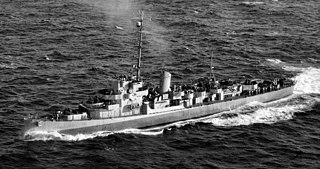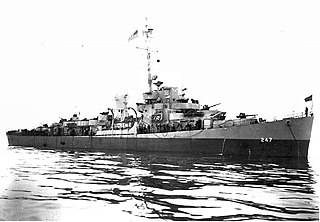
USS Hogan (DD-178/DMS-6) was a Wickes-class destroyer in the United States Navy during World War II.

USS Goff (DD-247) was a United States Navy Clemson-class destroyer in commission from 1921 to 1931 and from 1932 to 1945. She saw service during the Second Nicaraguan Campaign and World War II. She was named for Secretary of the Navy Nathan Goff, Jr.

USS Acree (DE-167) was a Cannon-class destroyer escort in service the United States Navy from 1943 to 1946. She was scrapped in 1973.

USS Macomb (DD-458/DMS-23) was a Gleaves-class destroyer of the United States Navy, named for Commodore William H. Macomb (1819–1872) and Rear Admiral David B. Macomb (1827–1911).

USS Jeffers (DD-621/DMS-27), a Gleaves-class destroyer, was the only ship of the United States Navy to be named for Commodore William N. Jeffers.

USS Walton (DE-361) was a John C. Butler-class destroyer escort in the United States Navy. It was named after Merrit Cecil Walton, a Marine Corps platoon sergeant with the U.S. 1st Marine Division, who died on Gavutu during the Battle of Guadalcanal and was posthumously awarded the Navy Cross for "extraordinary heroism".

USS Weeden (DE-797) was a Buckley-class destroyer escort in service with the United States Navy from 1944 to 1946 and from 1950 to 1958. She was scrapped in 1969.

USS Alexander J. Luke (DE/DER-577), a Buckley-class destroyer escort of the United States Navy, was named in honor of Sergeant Alexander J. Luke (1916–1942), who was killed in action during the attack on Tulagi on 6 August 1942. He was posthumously awarded the Silver Star.

USS Nields (DD-616) was a Benson-class destroyer in the United States Navy during World War II.

USS Stewart (DE–238) is an Edsall-class destroyer escort, the third United States Navy ship so named. This ship was named for Rear Admiral Charles Stewart, who commanded USS Constitution during the War of 1812. Stewart is one of only two preserved destroyer escorts in the U.S. and is the only Edsall-class vessel to be preserved. She is on display in Galveston, Texas as a museum ship and is open to the public.

USS Burrows (DE-105) was a Cannon-class destroyer escort built for the U.S. Navy during World War II. She served in both the Atlantic Ocean and the Pacific Ocean, and provided escort service against submarine and air attack for Navy vessels and convoys.

USS Trumpeter (DE-180) was a Cannon-class destroyer escort in service with the United States Navy from 1943 to 1947. She was sold for scrap in 1974.

USS Tomich (DE-242) was an Edsall-class destroyer escort in service with the United States Navy from 1943 to 1946. She was scrapped in 1974.

USS Stanton (DE-247) was an Edsall-class destroyer escort built for the U.S. Navy during World War II. She served in the Atlantic Ocean the Pacific Ocean and provided destroyer escort protection against submarine and air attack for Navy vessels and convoys.

USS Marchand (DE-249) was an Edsall-class destroyer escort in service with the United States Navy from 1943 to 1947. She was scrapped in 1974.

USS Woodson (DE-359) was a John C. Butler-class destroyer escort acquired by the United States Navy during World War II. The primary purpose of the destroyer escort was to escort and protect ships in convoy, in addition to other tasks as assigned, such as patrol or radar picket.
USS Johnnie Hutchins (DE-360) was a John C. Butler-class destroyer escort acquired by the U.S. Navy during World War II. The primary purpose of the destroyer escort was to escort and protect ships in convoy, in addition to other tasks as assigned, such as patrol or radar picket. She served in the Pacific Ocean, and, post-war, she returned home with a Navy Unit Commendation awarded to her for her battle with Japanese midget submarines on 9 August 1945.

USS Chester T. O’Brien (DE-421) was a John C. Butler-class destroyer escort in service with the United States Navy from 1944 to 1946 and from 1951 to 1960. She was scrapped in 1974.

USS Weber (DE-675/APD-75) was a Buckley-class destroyer escort of the United States Navy, named in honor of Ensign Frederick T. Weber (1916–1942), a naval aviator who was posthumously awarded the Navy Cross for heroism during the Battle of Midway.

USS Loeser was a Buckley-class destroyer escort of the United States Navy, named in honor of Lieutenant Commander Arthur E. Loeser (1903–1942).



















